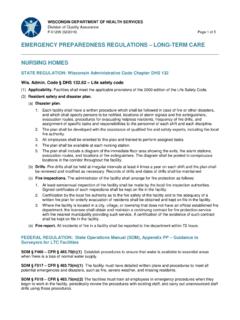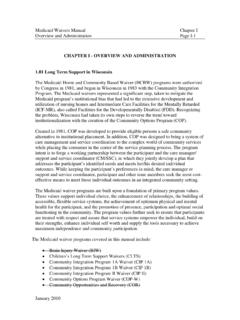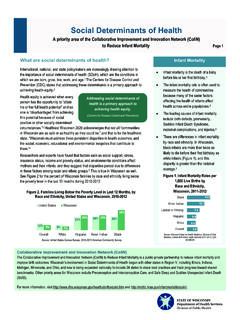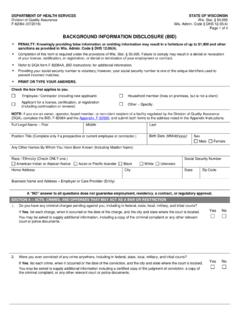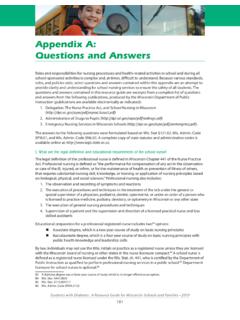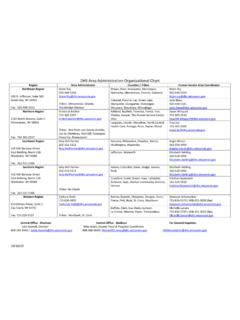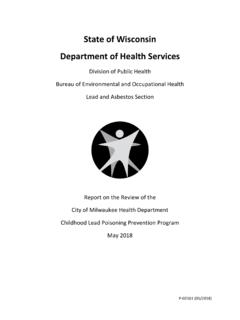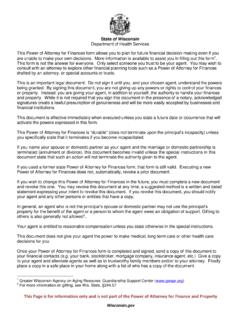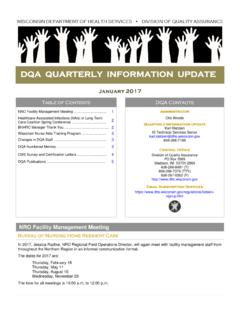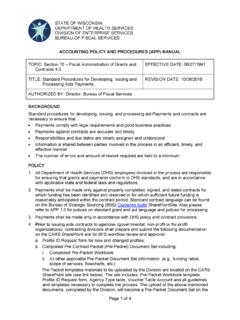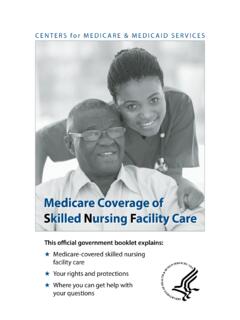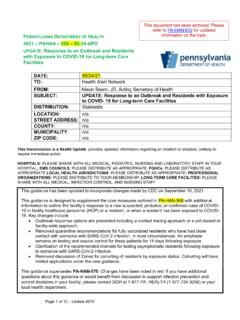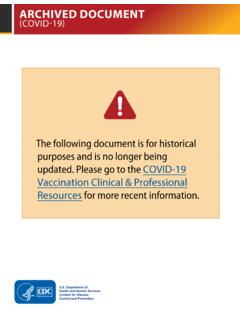Transcription of STATE OF WISCONSIN 1 W
1 STATE OF WISCONSIN 1 West Wilson Street Department of Health Services PO Box 2659. Division of Public Health Madison WI 53701-2659. Telephone: 608-267-9003. Fax: 608-261-4976. TTY: 888-701-1253. Date: December 23, 2021 BCD 2021-13. To: WISCONSIN Local Health Departments, Tribal Health Agencies, Infection Preventionists, Division of Quality Assurance, WISCONSIN DON Council, WISCONSIN LTC Medical Directors Association, WISCONSIN Health care Association, LeadingAge WISCONSIN , WISCONSIN Assisted Living Association From: Ryan Westergaard, MD, PhD, MPH. Chief Medical Officer and STATE Epidemiologist Thomas Haupt, MS. Respiratory Disease Epidemiologist Prevention and Control of Acute Respiratory Illness Outbreaks in long -Term care Facilities PLEASE DISTRIBUTE WIDELY.
2 Summary This memo is intended as guidance to medical and administrative staff of long -term care facilities (LTCFs), including skilled nursing facilities (SNFs), community-based residential facilities (CBRFs), and residential care apartment complexes (RCACs), in WISCONSIN . The unpredictable nature of the COVID-19 pandemic, emerging information about SARS-CoV-2, and fluctuations in COVID-19 disease activity may necessitate future changes to this guidance . Refer to the Centers for Disease Control and Prevention (CDC) or WISCONSIN Department of Health Services (DHS) websites for the most up-to-date information. Requirements for the timing of reporting, once a disease or condition is recognized or suspected, vary by disease. In addition to the information listed below, general reporting requirements are described in Wis.
3 Stat. ch. 252 Communicable Diseases. The specific reporting requirements are described in Wis. Admin Code. ch. DHS 145 Control of Communicable Diseases. Confirmed or suspected outbreaks of any disease in health care facilities, including LTCFs, are a Category I Disease, meaning they shall be reported IMMEDIATELY by telephone to the patient's local health officer, or to the local health officer's designee, upon identification. When an outbreak of acute respiratory illness (ARI) (COVID-19 or other viral respiratory disease) is suspected, testing to determine the etiology of the disease is essential to determine the appropriate precautions needed to control the outbreak. Until the cause(s) of an ARI outbreak is determined, facilities should initiate empiric precautions at the most protective level among common ARIs ( , those for residents with suspected COVID-19), including gown, gloves, fit tested N95, and eye protection ( , goggles or face shield).
4 DPH Memo Page 2 of 10. Definition of terms Used Acute respiratory illness (ARI) is defined as illness characterized by any two (2) of the following: Fever*. Cough (new or worsening, productive or nonproductive). Rhinorrhea (runny nose) or nasal congestion Sore throat Myalgia (muscle aches) greater than the resident's norm Shortness of breath or difficulty breathing Low SpO2 (oxygen saturation in the blood, normal levels are between 95 and 100%, but may vary for people with certain medical conditions). New loss of taste or smell *Fever may be difficult to determine among elderly residents. Therefore, the definition of fever used for ARI. is defined as temperature two degrees (2 F) above the established baseline for that resident. Pneumonia is defined as radiographic evidence of new or increased pulmonary infiltrates, usually accompanied by fever.
5 It is strongly recommended that all clinically diagnosed pneumonia be followed with radiographic testing. A suspected respiratory disease outbreak in a LTCF is defined by the Division of Public Health (DPH) as three or more residents and/or staff from the same unit with illness onsets within 72 hours of each other and who have: Pneumonia, or ARI, or Laboratory-confirmed viral or bacterial infection (including influenza). A suspect COVID-19 outbreak in a LTCF is defined by DPH as one or more residents and/or staff (who worked during their infectious period) within a facility who have a case of COVID-19. Laboratory Testing: Acute Respiratory Disease Outbreaks When an outbreak of acute respiratory illness (COVID-19 or other viral respiratory disease) is suspected, testing to determine the etiology of the disease is essential to determine the appropriate precautions needed to control the outbreak.
6 Nasopharyngeal swabs (preferred) or oropharyngeal swabs collected from residents or staff should be sent for multiplex PCR testing. Specimens can be sent to any laboratory that performs multiplex testing or, with prior DPH approval, specimens can be sent to the WISCONSIN STATE Laboratory of Hygiene (WSLH) where testing will be done free of charge. Specimens for non-COVID respiratory outbreaks should be collected within five days after the onset of illness and placed in viral transport media to assure optimal test results. If specimens will be submitted to the WSLH, include the WSLH lab requisition form. Facilities may choose to have clinical specimens tested at a laboratory other than the WSLH, however, fee-exempt testing cannot be offered for tests performed at those laboratories, other than as part of STATE -contracted laboratory services for COVID-19 testing.
7 Due to possible false positive results when using rapid influenza tests, especially when testing occurs during periods of low influenza activity, confirmatory testing of positive rapid test results using RT- PCR or viral culture should be performed. With DPH approval, specimens may also be tested for other respiratory viruses. DPH Memo Page 3 of 10. If test results confirm influenza or SARS-CoV-2 within a facility, no further testing will be performed unless the resident has an atypical presentation of illness or is not responding to treatment. A negative test result does not rule out viral infection or the existence of an outbreak. Laboratory Testing: COVID-19 Outbreaks COVID-19 outbreaks have different outbreak testing guidance and procedures based on the type of facility, including CMS requirements for skilled nursing facilities (SNFs) and DHS COVID testing guidance for assisted living facilities (ALFs).
8 In both of these cases, testing should be done to establish the extent of the outbreak and any transmission at minimum. WSLH and other STATE -contracted labs will test any symptomatic resident or staff for SARS-CoV-2, as well as provide outbreak testing. If SARS-CoV-2 is identified, facilities should determine a testing approach, either targeted based on contact tracing or a wider approach, per CDC LTCF guidance . Testing of the targeted individuals or location(s). should be done at minimum immediately (defined as no sooner than two days post-exposure) and 5 7 days post-exposure if no cases are found immediately. If additional cases are found during either testing cycle, facilities should continue testing for the targeted location(s) or facility-wide every 3 7 days until 14 days pass since the last identified positive.
9 If facilities are not confident in the ability to conduct contact tracing or the situation warrants wider testing, they should explore broader testing of location(s) or facility-wide. If cases are identified after an initial contact tracing testing approach, facilities should conduct contact tracing for the additional cases and also consider expanding the testing approach more broadly. Nursing homes should follow any testing mandates issued by the Centers for Medicare and Medicaid Services. Other LTCFs with confirmed COVID-19 should test residents and/or staff for COVID-19 based on the current recommendations on the DHS website. Testing and supplies are provided for fee-exempt testing through WSLH or participating private or clinical labs. More information about requesting testing supplies can be found on the DHS COVID testing website.
10 Antiviral Treatment and Prophylaxis During Influenza Outbreaks Influenza antiviral prophylaxis may prevent further spread of infection during outbreaks of influenza in a LTCF. Ideally, within 48 hours of the onset of illness, treat residents with confirmed or suspect cases of influenza with oseltamivir (Tamiflu ), zanamivir (Relenza ), or baloxovir (Xofluza ) to reduce the severity and shorten the duration of illness. At the discretion of a clinician, treatment with oseltamivir (Tamiflu ) or zanamivir (Relenza ) can be initiated more than 48 hours after the onset of illness. Because of identified resistance, adamantanes should not be used to treat or prevent cases of influenza A. Both pd2009/H1N1. and seasonal H3N2 viruses are resistant to adamantanes (amantadine, rimantadine, Symadine , Symmetrel , Flumadine ).
